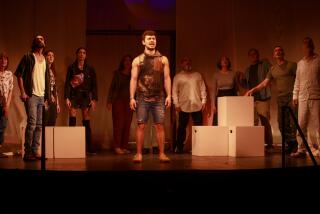‘Alma’ is a muse in motion
- Share via
Because the Israeli playwright Joshua Sobol got roasted on a political hot seat in Haifa 17 years ago, theatergoers in Los Angeles -- well, those willing to pay $125 -- now get to experience a sprawling, unorthodox historical fantasia in one of the most lavish, yet intimately partitioned, performance spaces they’re likely to visit, and dine on wiener schnitzel, goulash and Austrian pastries during intermission.
The play is “Alma,” which fractures the long and incident-laden life of the Viennese muse-consort-femme fatale Alma Mahler into a broken mirror of 50 scenes in 15 settings. The venue is the Los Angeles Theatre, a long-vacant 1931 downtown movie palace that’s ornately carved, curtained and gilded in the French Baroque style of the age of Louis XIV. The buffet feast is immovable. Everything else in what Sobol and Viennese producer-director Paulus Manker have termed their “polydrama” requires audience members to embark on an odyssey, following trails of their own devising as they choose among simultaneous scenes set in various nooks of the theater. In one sequence, playgoers can board a 1920s bus in an alleyway behind the auditorium and take a tour of downtown L.A.
Sobol already was one of the most acclaimed and controversial writers for the Israeli stage when his “Jerusalem Syndrome” premiered in December 1987, at the Haifa Municipal Theatre, where he was co-artistic director. Through the prism of the occupying Roman legions’ persecution of the Jews in ancient times, Sobol examined the dilemmas posed nearly 2,000 years later by Israel’s occupation of Palestinian territories. The play set off a national outcry and led to Sobol’s resignation as artistic director.
His exit made Sobol think of Gustav Mahler, one of his favorite composers. Buffeted by complaints over artistic policy and targeted by anti-Semites, Mahler lost his post as director of the Vienna Court Opera in 1907 and soon left the city. But as Sobol researched the great musician for a play, his attention became fixed on Mahler’s wife, Alma. In this, he was hardly alone.
Considered one of the most alluring women of her time, Alma was a connoisseur of talent, intent on lavishing not just her admiration but her affections on men of genius. She buried two artistic-lion husbands, Mahler (who had forced her to give up her own aspirations as a composer) and novelist-playwright Franz Werfel, author of “The Song of Bernadette” and “Jacobowsky and the Colonel.” In between, she married and divorced a third creative eminence, Bauhaus architect Walter Gropius. There were affairs, of course. Perhaps the most steamy, with painter Oskar Kokoschka, led him after he was dumped to exorcise his pain by ordering a custom-made, life-size nude doll of his lost lover, which he ritualistically beheaded at a party.
A new experience
Sobol soon recovered from the “Jerusalem Syndrome” upheaval. “Ghetto,” an earlier play about Lithuanian Jews trying to survive under the Nazis (it had its English-language premiere at the Mark Taper Forum in 1986), became a hit in London in 1989. Around that time, the playwright met Manker, and they discovered a mutual interest in toying with how audiences experience theater.
In the mid-1990s, they set out to approximate the free-wandering, self-propelled experience of Web-surfing. First they hit upon a form -- a menu of simultaneous, multiple scenes that challenges each viewer to create his or her own path through the play. Then Sobol realized that the Alma Mahler drama he had researched but not yet written would provide the ideal content, given the complex, multifaceted nature of her life and those of the men she captivated.
Manker acknowledges that the play’s logistics owe “a bit” to his having seen the long-running L.A. stage phenomenon “Tamara” in the early 1990s. Like the creators of that tale of eros and intrigue in 1920s Fascist Italy, Sobol and Manker liken the audience’s role to that of a camera. With no fixed seating, spectators are free to move from location to location, from scene to scene, and to zoom in as close as they like, even positioning themselves virtually on top of the actors -- as long as they don’t actually touch the players or interrupt the dialogue.
Sobol, who wrote “Alma” in English to be on common linguistic ground with the Hebrew-lacking Manker, invested the play with dollops of satiric humor and theatrical reality-bending. There are three young Almas, who sometimes appear together, plus an elderly vision of the enchantress to preside over the evening, treating playgoers as guests at her 125th birthday party.
“Alma” played for six consecutive summers in Vienna, starting in 1996. Manker decided to turn it into a roadshow, with stops in cities figuring prominently in Alma Mahler’s life. The play occupied a 17th century canal-front palazzo in Venice during 2002, and was staged last year in Lisbon, where Alma and Werfel landed in 1940 as they fled the Nazis. Los Angeles is where they settled as “The Song of Bernadette” was made into a film, and it’s where Werfel died in 1945. Next year, Manker hopes to conclude the play’s journey in New York City, where Alma Mahler died in 1964, at age 85.
Manker scouted L.A. locations late last year and fell in love with the Los Angeles Theatre. Its cathedral-like lobby, a regal outburst of carvings and gold paint, features four sculpted fairies soaring naked near the high-vaulting ceiling.
In the auditorium, a large, satanic carved head glowers down on the ornately curtained stage from a perch high on the wall. Yes, says the intense, sometimes hyperbolic producer-director, he was warned that good business sense dictated a Westside or Hollywood location, not a section of downtown that is not the Music Center and is therefore unproven for pricey performances.
“This is the ideal place,” he insists. “Why should I settle for second best? It’s a sleeping beauty, and we’re going to kiss it.”
The cost of the production is “a lot,” Manker says, unwilling to be more specific. Each of the play’s incarnations has been designed for a maximum audience of 200 people per night, and none of them, he says, would have been possible without large sponsorships -- including a combined $500,000 for the 10-week L.A. run from Swarovski, an Austrian cut-crystal company, and from cultural agencies of the Austrian and Viennese governments.
Sobol, a polite, thoughtful man of 65, continues to write about the agonizing choices Israel faces in its conflict with the Palestinians. He says his work, including recent plays and novels about soldiers and intelligence agents who refuse to serve in the occupation, no longer causes great outrage in a land habituated to seemingly ceaseless violence, and to unending debate over what should be done in the face of it. “Israel has become much more open than it was 15 years ago to controversial attitudes,” he says with a lightly ironic chuckle.
As for Alma, Sobol finds her impossible to pin down and considers it fitting that each playgoer will get a fragmentary, less-than-definitive vision of his heroine.
In researching and writing the show, he says, he came to realize that each human being is “inexhaustible.”
“There’s no way of telling the one and only, true story about a character. The more intimately you know a person, the more you marvel about the mystery of the human phenomenon.”
*
‘Alma’
Where: Los Angeles Theatre, 615 S. Broadway, Los Angeles
When: 7 p.m. Thursdays through Saturdays, 6 p.m. Sundays
Ends: Dec. 5
Price: $125 (includes dinner)
Contact: (213) 688-2994
More to Read
The biggest entertainment stories
Get our big stories about Hollywood, film, television, music, arts, culture and more right in your inbox as soon as they publish.
You may occasionally receive promotional content from the Los Angeles Times.











